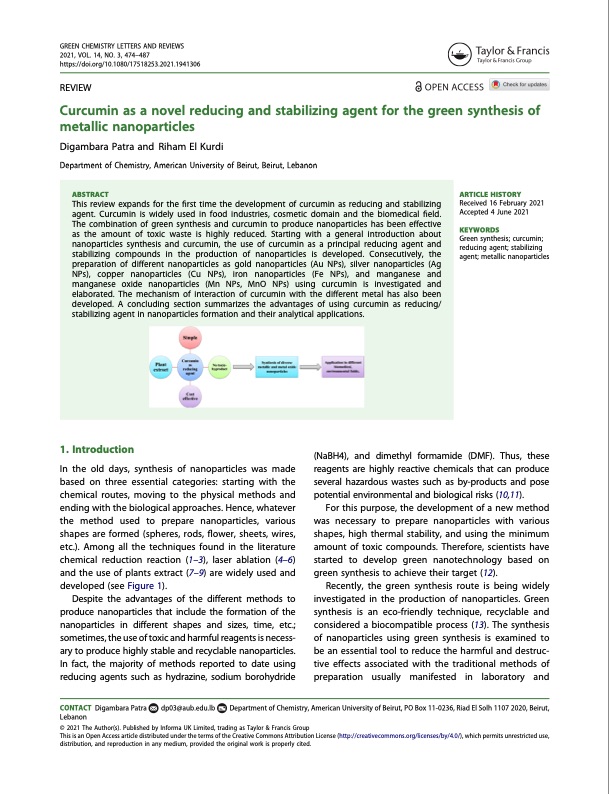
PDF Publication Title:
Text from PDF Page: 002
GREEN CHEMISTRY LETTERS AND REVIEWS 2021, VOL. 14, NO. 3, 474–487 https://doi.org/10.1080/17518253.2021.1941306 REVIEW Curcumin as a novel reducing and stabilizing agent for the green synthesis of metallic nanoparticles Digambara Patra and Riham El Kurdi Department of Chemistry, American University of Beirut, Beirut, Lebanon ABSTRACT This review expands for the first time the development of curcumin as reducing and stabilizing agent. Curcumin is widely used in food industries, cosmetic domain and the biomedical field. The combination of green synthesis and curcumin to produce nanoparticles has been effective as the amount of toxic waste is highly reduced. Starting with a general introduction about nanoparticles synthesis and curcumin, the use of curcumin as a principal reducing agent and stabilizing compounds in the production of nanoparticles is developed. Consecutively, the preparation of different nanoparticles as gold nanoparticles (Au NPs), silver nanoparticles (Ag NPs), copper nanoparticles (Cu NPs), iron nanoparticles (Fe NPs), and manganese and manganese oxide nanoparticles (Mn NPs, MnO NPs) using curcumin is investigated and elaborated. The mechanism of interaction of curcumin with the different metal has also been developed. A concluding section summarizes the advantages of using curcumin as reducing/ stabilizing agent in nanoparticles formation and their analytical applications. 1. Introduction In the old days, synthesis of nanoparticles was made based on three essential categories: starting with the chemical routes, moving to the physical methods and ending with the biological approaches. Hence, whatever the method used to prepare nanoparticles, various shapes are formed (spheres, rods, flower, sheets, wires, etc.). Among all the techniques found in the literature chemical reduction reaction (1–3), laser ablation (4–6) and the use of plants extract (7–9) are widely used and developed (see Figure 1). Despite the advantages of the different methods to produce nanoparticles that include the formation of the nanoparticles in different shapes and sizes, time, etc.; sometimes, the use of toxic and harmful reagents is necess- ary to produce highly stable and recyclable nanoparticles. In fact, the majority of methods reported to date using reducing agents such as hydrazine, sodium borohydride (NaBH4), and dimethyl formamide (DMF). Thus, these reagents are highly reactive chemicals that can produce several hazardous wastes such as by-products and pose potential environmental and biological risks (10,11). For this purpose, the development of a new method was necessary to prepare nanoparticles with various shapes, high thermal stability, and using the minimum amount of toxic compounds. Therefore, scientists have started to develop green nanotechnology based on green synthesis to achieve their target (12). Recently, the green synthesis route is being widely investigated in the production of nanoparticles. Green synthesis is an eco-friendly technique, recyclable and considered a biocompatible process (13). The synthesis of nanoparticles using green synthesis is examined to be an essential tool to reduce the harmful and destruc- tive effects associated with the traditional methods of preparation usually manifested in laboratory and ARTICLE HISTORY Received 16 February 2021 Accepted 4 June 2021 KEYWORDS Green synthesis; curcumin; reducing agent; stabilizing agent; metallic nanoparticles CONTACT Digambara Patra dp03@aub.edu.lb Department of Chemistry, American University of Beirut, PO Box 11-0236, Riad El Solh 1107 2020, Beirut, Lebanon © 2021 The Author(s). Published by Informa UK Limited, trading as Taylor & Francis Group This is an Open Access article distributed under the terms of the Creative Commons Attribution License (http://creativecommons.org/licenses/by/4.0/), which permits unrestricted use, distribution, and reproduction in any medium, provided the original work is properly cited.PDF Image | Curcumin as a novel agent for metallic nanoparticles

PDF Search Title:
Curcumin as a novel agent for metallic nanoparticlesOriginal File Name Searched:
Curcumin-nanoparticles.pdfDIY PDF Search: Google It | Yahoo | Bing
CO2 Organic Rankine Cycle Experimenter Platform The supercritical CO2 phase change system is both a heat pump and organic rankine cycle which can be used for those purposes and as a supercritical extractor for advanced subcritical and supercritical extraction technology. Uses include producing nanoparticles, precious metal CO2 extraction, lithium battery recycling, and other applications... More Info
Heat Pumps CO2 ORC Heat Pump System Platform More Info
| CONTACT TEL: 608-238-6001 Email: greg@infinityturbine.com | RSS | AMP |